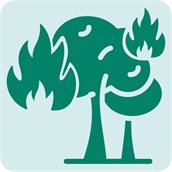Wildfire
Wildfires are any unplanned or uncontrolled fire affecting natural, cultural, industrial, and residential landscapes. In the Netherlands, the Dutch Institute for Public Safety (NIPV)(PDF) distinguishes four types of fire once a wildfire has started:
- Ground fires burn below the surface, in soil that contains organic matter like peat. These fires smoulder slowly and can produce heavy smoke for a long time. They usually occur during droughts, when groundwater levels are low and the soil is dry.
- Surface fires burn through vegetation that is directly on the ground, such as grass, leaves, and small shrubs.
- Crown fires rage through the tops of trees, known as the crowns.
- Spot fires are fires that start when burning or smouldering vegetation are carried by the wind and ignite new areas, sometimes far from the original fire.
How wildfires occur
A report (PDF) by the NIPV, Deltares, Wageningen University & Research and the Royal Netherlands Meteorological Institute (KNMI) explains that three conditions must be met for any wildfire to occur:
- There must be enough fuel, known as biomass. This includes natural materials, like plants, peat, and trees. Some types of biomass ignite more easily than others, depending on fuel characteristics such as moisture content, size, shape and fuel load. The type of fuel also determines how easily a fire can spread when ignited (see section Types of wildfires). The type of biomass also determines the amount of heat that can be released, resulting in less or more intense fires.
- Meteorological and soil-specific characteristics: A fire can occur more easily in drought conditions in combination with soil types. For example, sandy soils retain less moisture, which can cause vegetation to dry out and increase the likelihood of ignition.
- A fire needs a source of ignition to start, which depends on location-specific characteristics. Wildfires can ignite naturally, such as from lightning strikes, although this is rare in the Netherlands. More often, wildfires are caused by human activity, either through careless action (like hot exhaust pipes or discarded cigarettes) or intentional actions (such as arson).
Spread and duration
Once the wildfire occurs, several factors (PDF) influence the spread and duration of the wildfire. These include vegetation type, topography, and local climate and weather conditions. Soil composition also affects smoke production and flame behaviour, in addition to the fire’s spread and duration. Moreover, the speed at which the fire is detected, the accessibility of the area, and the response time of the fire brigade play a critical role in the spread of the wildfire.
Impact of wildfires
Between 2017 and 2022, the Netherlands experienced approximately 3,667 wildfires, according to a study by Wageningen University & Research, NIPV, and Deltares. On average, wildfires burn a surface area of about 405 hectares annually. The impacts of wildfires span multiple domains: environmental effects, physical, social, and mental impacts on individuals, economic effects tied to resource availability, and cultural impacts.
In recent years, several wildfires led to major evacuation efforts, such as the fire in National Park De Meinweg in April 2020, when 4,000 citizens were evacuated. Impacts can be direct damage to buildings, infrastructure or nature. Indirect damage are socio-economic disruptions, such as damage to telecommunications and electricity networks. Another example is the closure of roads or railways because of low visibility from smoke or to make way for emergency vehicles. According to the NIPV Wildfire Signal ’23 (PDF), businesses can experience impacts in a variety of ways. From direct damage to assets to indirect damage via supply chain disruptions. Moreover, about halve of the businesses that experienced direct impacts from major wildfires go bankrupt within 2 years.
Damage to nature reserves from wildfires typically range from €900 to €1,200 per hectare, based on restoration costs. However, damage can reach up to €6,000 in severe cases such as the 2011 Kalmthoutse Heide fire. While high-intensity fires can harm soil quality, flora, and fauna, low-intensity fires may cause limited damage and can even promote biodiversity in heathland areas.
Wildfires can significantly affect people’s health and safety. Firefighters face high temperatures and physically demanding conditions, increasing the risk of exhaustion, overheating, and reduced alertness. Smoke exposure poses additional risks for both emergency workers and civilians, including breathing difficulties and poor visibility, which has caused traffic accidents such as during the 2020 Deurnese Peel fire. In the Netherlands, 29 wildfire-related fatalities have been recorded since 1833, most during major peat fires in the 19th and early 20th centuries, with later cases involving firefighting or training incidents.
It should be noted that these impacts are largely unquantified and remain relatively underexplored. The Netherlands Environmental Assessment Agency (PBL), Wageningen University & Research, and Deltares are collaborating to develop more detailed insights into wildfire risk, and how to distinguish its impacts.
Action perspective
The Dutch Institute for Public Safety’s report (PDF) explains that the impact of wildfires strongly depends on the presence of natural barriers – measures designed to slow down the fire or stop it from spreading further. Other key factors include how quickly the fire is detected, the fire brigade’s response time, tactical knowledge, shift capacity and relief cycles, and how easily they can reach the area. More information on this can be found on the policies & regulations page.

